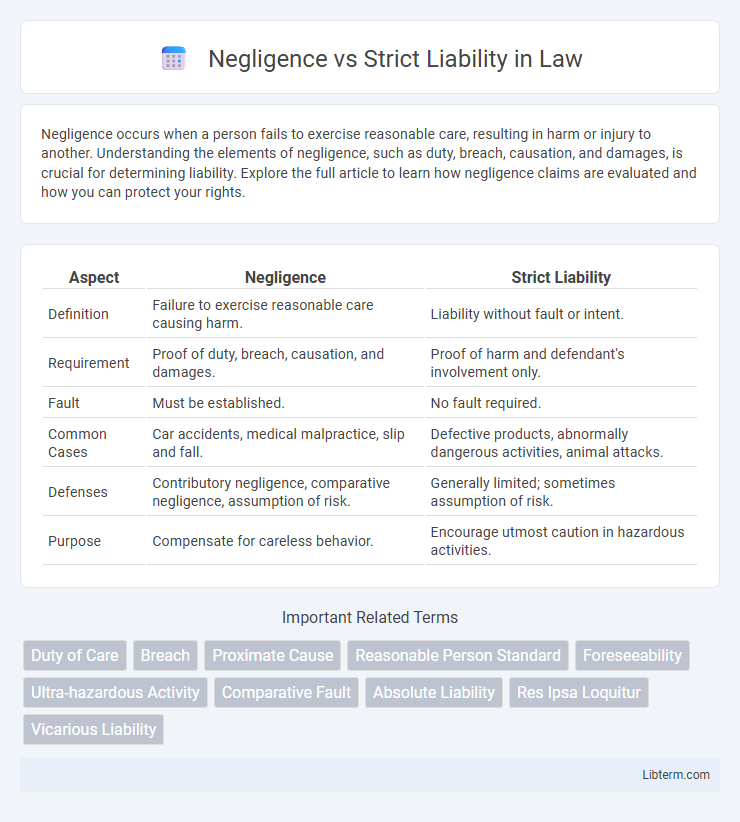Negligence occurs when a person fails to exercise reasonable care, resulting in harm or injury to another. Understanding the elements of negligence, such as duty, breach, causation, and damages, is crucial for determining liability. Explore the full article to learn how negligence claims are evaluated and how you can protect your rights.
Table of Comparison
| Aspect | Negligence | Strict Liability |
|---|---|---|
| Definition | Failure to exercise reasonable care causing harm. | Liability without fault or intent. |
| Requirement | Proof of duty, breach, causation, and damages. | Proof of harm and defendant's involvement only. |
| Fault | Must be established. | No fault required. |
| Common Cases | Car accidents, medical malpractice, slip and fall. | Defective products, abnormally dangerous activities, animal attacks. |
| Defenses | Contributory negligence, comparative negligence, assumption of risk. | Generally limited; sometimes assumption of risk. |
| Purpose | Compensate for careless behavior. | Encourage utmost caution in hazardous activities. |
Understanding Negligence: Definition and Key Elements
Negligence involves a failure to exercise reasonable care, leading to unintentional harm or damage to another party. Key elements include duty of care, breach of that duty, causation linking the breach to the injury, and actual damages suffered by the plaintiff. Understanding these components is essential for distinguishing negligence from strict liability, where fault does not need to be proven.
Strict Liability Explained: What Does It Mean?
Strict liability is a legal doctrine holding a party responsible for damages or injuries regardless of fault or intent, often applied in inherently hazardous activities or defective product cases. This means the plaintiff does not need to prove negligence, only that the injury or damage occurred and the defendant was responsible for the activity or product. Strict liability aims to promote safety and accountability by ensuring those engaged in risky endeavors bear the cost of any resulting harm.
Fundamental Differences Between Negligence and Strict Liability
Negligence requires proving a breach of a duty of care resulting in harm, emphasizing the defendant's fault or intent. Strict liability imposes responsibility regardless of fault, primarily applied in inherently dangerous activities or defective products. The fundamental difference lies in fault requirement, where negligence demands proof of carelessness, while strict liability enforces accountability irrespective of negligence.
Key Legal Principles in Negligence Cases
Negligence cases center on the breach of a duty of care owed by the defendant to the plaintiff, requiring proof that the defendant failed to act with reasonable care under the circumstances. Key legal principles include duty, breach, causation, and damages; the plaintiff must establish that the defendant's conduct directly caused harm or loss. Unlike strict liability, which imposes liability regardless of fault, negligence mandates demonstration of fault through the defendant's careless or irresponsible behavior.
When Does Strict Liability Apply? Common Scenarios
Strict liability applies primarily in cases involving inherently dangerous activities, such as using explosives or owning wild animals, where harm is caused regardless of fault or negligence. This legal principle often arises in product liability claims when a defective product causes injury, holding manufacturers accountable without the need to prove negligence. Common scenarios include ultra-hazardous activities, product defects, and abnormally dangerous conditions that pose significant risks to public safety.
Burden of Proof: Negligence vs Strict Liability
In negligence cases, the plaintiff bears the burden of proof to demonstrate that the defendant breached a duty of care, resulting in harm or damages. Strict liability shifts this burden, requiring the defendant to prove that they were not responsible for the harm, as liability is imposed regardless of fault or intent. The distinction in burden of proof fundamentally alters case strategies and potential outcomes in tort law disputes.
Defenses Available in Negligence and Strict Liability Claims
Defenses available in negligence claims include contributory negligence, comparative negligence, assumption of risk, and consent, which can reduce or eliminate the defendant's liability based on the plaintiff's own actions or agreements. Strict liability defenses are limited but may involve showing the absence of causation, that the plaintiff failed to prove the defendant's product or action was defective or abnormally dangerous, or proof of plaintiff's misuse of the product. Understanding the distinctions in available defenses is crucial for litigating or defending claims in personal injury, product liability, and other tort cases.
Real-World Examples: Negligence and Strict Liability in Practice
Negligence in real-world cases often involves proving a duty of care breach, such as a driver causing an accident by running a red light, demonstrating failure to act reasonably. Strict liability applies regardless of fault, commonly seen in product liability cases where manufacturers are held responsible for defective products causing harm, like a faulty airbag deployment. Both legal concepts protect victims but differ in proof requirements, reflecting practical approaches to accountability in tort law.
Implications for Plaintiffs and Defendants
Negligence requires plaintiffs to prove the defendant's breach of a duty of care and causation of harm, making it challenging to establish liability. Strict liability imposes responsibility on defendants regardless of fault, simplifying the plaintiff's burden but increasing defendants' risk, especially in inherently hazardous activities. For defendants, strict liability demands rigorous safety measures, while negligence allows defense based on reasonable conduct and absence of fault.
Choosing the Right Legal Approach: Negligence or Strict Liability?
Choosing the right legal approach between negligence and strict liability depends on the nature of the case and the evidence available. Negligence requires proving a breach of duty and causation, ideal when fault and carelessness are clear, while strict liability holds a party responsible regardless of fault, often used in inherently dangerous activities or defective product cases. Evaluating the facts, applicable statutes, and potential defenses helps determine the most effective strategy for achieving liability and compensation.
Negligence Infographic

 libterm.com
libterm.com